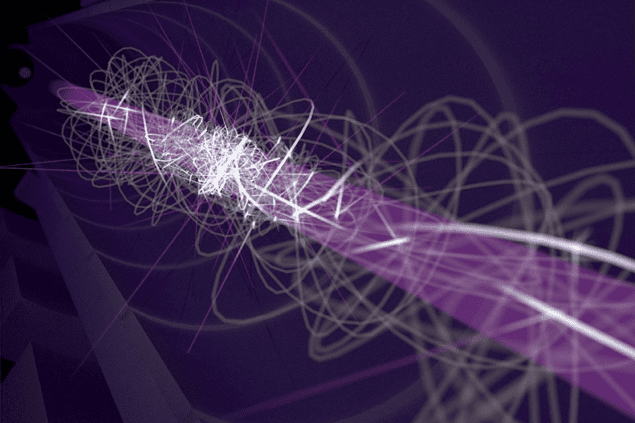
Antihydrogen atoms have been laser-cooled for the first time, paving the way for precision studies that could reveal why there is much more matter that antimatter in the universe. The cooling was done by an international team of physicists at CERN in Switzerland, who used a new type of laser to cool the antiatoms and then measured a key electronic transition in antihydrogen with unprecedented precision. Their breakthrough could lead to improved tests of other key properties of antimatter.
In every process ever observed in the laboratory and almost every process predicted by the Standard Model of particle physics, the creation of a particle is always accompanied by the creation of its antiparticle. Conversely, when a particle and its antiparticle meet, the two annihilate. One indisputable fact, however, is that we live in a universe that is made almost entirely of matter – raising the question of how lots of matter was created without an equivalent quantity of antimatter at the Big Bang.
In the Standard Model, the physical properties of a particle (such as an electron) appear to be equal and opposite to its antimatter equivalent (the positron) – electrons and positrons have the same mass but opposite electrical charge, for example. Therefore, looking for tiny differences between particles and their antimatter equivalents could shed light on the matter-antimatter asymmetry in the universe. One way of doing this is to make and study antihydrogen, which comprises a positron and an antiproton.
Annihilation problem
As with ordinary hydrogen, the quantum properties of antihydrogen become clearer at low temperatures. Cooling antiatoms like antihydrogen, however, is far from straightforward. Many techniques for cooling matter are simply unavailable: sympathetic cooling, in which the atoms lose energy by colliding with different atoms, is not feasible as they would annihilate. Evaporative cooling, in which all but the very coldest atoms leave the trap, taking the energy with them, is currently impossible because antiatoms are so hard to produce: “It’s just not an option with antimatter,” says Jeffrey Hangst of Aarhus University in Denmark, who works on the Antihydrogen Laser Physics Apparatus (ALPHA) experiment at CERN; “We don’t have the numbers; we don’t have the density.”
One possibility is Doppler cooling, which works – paradoxically – by exciting the atoms. If the atoms are irradiated with a laser frequency just below that needed to excite an electronic transition, an atom moving towards the beam will see the radiation blue-shifted and may absorb a photon. When this excited state decays, it emits more energy than it originally absorbed, cooling the sample. This technique is widely used with other atoms but faces a problem with hydrogen – the one atom whose antimatter counterpart has so far been produced. The only suitable transition is the Lyman-alpha transition between the 1s and 2p orbitals, involves light at vacuum ultraviolet wavelengths around 121 nm. However, there are no practical lasers operating in this region and efforts to develop a continuous wave 121 nm laser had foundered after years of attempts.
“A lot of grief”
For the new work, fellow ALPHA member Makoto Fujiwara from TRIUMF in Canada suggested they try pulsed laser cooling and, together with colleagues, set out to produce a device that produced 121.6 nm laser pulses from 729.4 nm continuous wave laser light: “In retrospect it seems like kind of an obvious thing to do,” says Fujiwara, but Hangst says Fujiwara “took a lot of grief from some of our colleagues when he proposed this and when they started building the laser”.
The researchers then designed a cylindrical magnetic trap with transparent ends. At one end, they injected antiprotons from CERN’s antiproton decelerator. At the other, they added positrons. After several hours, around 1000 antihydrogen atoms had accumulated in the centre of the trap. The researchers then used their laser to cool the atoms. They do not report a final temperature in their paper, as the atoms had not reached thermal equilibrium, but the sharpened Lyman-alpha peak revealed that the atoms were moving more slowly than had previously been achieved.
Einstein’s equivalence principle
The researchers next measured the frequency of the transition between the 1s and 2s orbitals in antihydrogen: “It’s the thing we understand best in hydrogen, it’s measured absolutely to a precision of about 10-15,” says Hangst, “and that’s the thing we want to compare with antihydrogen.” Their new results show an improved precision from cooling and they intend to report a comparison with hydrogen in future work. The team also wants to study other properties of antihydrogen, starting with Einstein’s equivalence principle, which says that matter and antimatter behave the same under gravity.

CERN physicists close in on antimatter–matter asymmetry
Fujiwara describes the team’s success as “revolutionary” and Vladan Vuletić of the Massachusetts Institute of Technology (who was not involved in the work) agrees: “The main challenge with cooling hydrogen or antihydrogen has always been…the generation of laser radiation at such short wavelengths with the necessary spectral purity…You’re building this on top of this very complex experiment: you first need to produce the antiprotons; you need to trap them together with the positrons in an electromagnetic trap; you need to neutralize them into antihydrogen and then on top of all that you need to bring in your laser cooling.”
The research is described in Nature.


